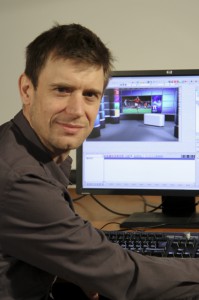SVGE Graphics Roundtable 2014 Part One: deltatre, ChyronHego, Orad, Ross Video, RT Software and Vizrt tackle the big broadcast issues
Such is the demand for on-screen information that graphics play an increasingly vital role in broadcast sports programming. For our first ever ‘Roundtable’ session, SVG Europe asked several leading players in the graphics field for their thoughts on three of the most pointed issues – cost control, second screen applications and Augmented Reality presentations. The participants in Part One are Ofir Benovici, vice president of Marketing, Orad; Jesper Gawell, chief marketing officer, ChyronHego; Luke Harrison, product manager, RT Software; Brian Olson, Director, Marketing Product Management & Business Development, XPression & Ross Virtual Solutions; Tony Page, head of graphics, deltatre UK; and Stephan Würmlin Stadler, EVP, Sports at Vizrt.
SVG Europe: The question of costs is an ever-present issue. How can economies be achieved in the sports graphics environment?
Ofir Benovici: Our main focus is to assist our customers to reduce their operational costs. That means that the architecture of our system is designed with that in mind. For example, we are offering a programming-free work environment. What does that mean? Template graphics can become quite complex in terms of the logic and behaviour of the graphics under different conditions. Typically, this logic will be programmed into the graphics’ templates – a costly and time-consuming process. Our programming-free environment allows the same on-air results by introducing a set of visual tools that enable the average user to introduce complex logic and behaviour to the graphics at a fraction of the time and cost. This is just one example.
Jesper Gawell: We’re helping our customers streamline their graphics production, and therefore reduce costs, on several levels. One approach is to ensure they can connect easily to external data feeds or sources. Another is to provide the means to drive broadcasters’ clock graphics directly from the official scoreboard or timing devices, instead of relying on manual scouting at the venues. Modern news production operations can teach sports broadcasters many things about efficient graphics workflows, since such teams have been working in this manner for almost a decade. Enabling journalists to fulfil graphics templates themselves, and systems that enable sharing and distribution of assets between different sites, are two examples that can be easily applied in sports production, too.
Luke Harrison: Hardware costs have already reduced with the advent of new PCs that have the same performance, or better, than previous models. The overall cost of owning software may prohibit lower end broadcasters from even getting on the ladder. As CiB solutions increase, there is a natural evolution to cloud-based output. Viewers are changing their habits more rapidly probably than the industry expected. It is hard to imagine the use of isolated real time broadcast graphics in the cloud having a place, unless it is part of an overall playout solution or as a bureau service for ‘shows’ such as weather. When graphics do exist as part of a wider solution the cost automatically goes down.
Brian Olson: We’re seeing a trend towards consolidating the score bug operator and the insert graphics operator into one person. That’s a significant saving when multiplied across all of the productions that occur in one year. This is now possible thanks to the multi-layered graphics playout, enhanced scoreboard connectivity, and frame-accurate switching capabilities available with Ross XPression. The technical director can now control graphic recalls from the switcher/vision mixer on specific layers. At the same time, the insert graphics operator manually recalls on other layers. To make it even more economical, media wipes, interstitials, and show openers can also play from the XPression graphics system, eliminating the need for dedicated clip servers and media stores. In addition to saving money, this approach also makes it easier to deliver media to the venue and simpler for the TD to set up. Ross’ openTruck initiative is based on this new approach to production — smaller profile vehicles, fewer pieces of kit, and less crew.
Tony Page: One area to reduce costs is by creating more efficient workflows, thus maximising both human and hardware resources. Using intuitive cloud-based production tools, we are able to give editors and producers the capability to prepare and create graphics based on sports event data feeds. Giving production staff the ability to quickly navigate and filter complex data sets to fulfil graphics templates, means the number of dedicated personnel can be significantly reduced. In a live sport environment, this navigation and filtering capability significantly reduces ‘prep’ time, allowing more content to air with the same staff levels. In a post production environment, coupling graphics tools, built for editors and producers, with cloud-based rendering technology, allows for the graphics content to be created without dedicated operators, and maximises the use of hardware/software. deltatre’s Magma suite of software was developed to harness the huge amount of data now generated around sporting events and provide tools to broadcasters to get that information on screen quickly and efficiently – as regular on-screen graphics, virtual analysis graphics or in studio graphics, such as touchscreens or Augmented Reality.
Stephan Stadler: Reliable integrations are key for cost reductions. When building a control room or OB van, broadcasters should keep in mind how systems integrate with each other. For us, a Tricaster switcher is uniquely suited to control our graphics engine, Viz Engine. We are able to provide an IP stream with a key channel and fill channel, instead of using SDI. This creates efficiency in infrastructure costs. The broadcaster can build an inexpensive IP-based infrastructure and still have the same quality. Other solutions such as working with automation systems like Viz Mosart, or tv-in-a-box systems like Viz Opus, can cut down the costs of multiple control systems.
SVG Europe: Second screen applications are increasing. How does that expansion impact on sports graphics work?
Benovici: In the context of graphic devices, we are looking at how we can visualise content generated by social media on the TV screen. Such content is a data source, and you can compare this to interfacing to a stat collection system during an event. Data is being collecting, moderated and organised and, after that, visualised by the graphic device. Our own social TV solution, Social Media Hub, offers a tool to aggregate, moderate and take to air content generated by social media. At the same time, it offers the unique capability of publishing content from the first screen to the second screen. It means content that was on display in the first screen is pushed as a clip to the second screen for additional usage.
Gawell: Sports fans are now enjoying some amazing applications that give them a much deeper perspective on the match, whether viewing at home or the venue. But it’s important to understand how these viewers are using the second screen. We know that the typical viewer still watches the main screen at home for the live action, but turns to the second at half time or during a break. Therefore, live production, including graphics, needs to focus primarily on the action, while second-screen applications should concentrate on deeper insight and provide an additional layer that complements, rather than competes with, the live broadcast. We’re now seeing a trend in which leagues and federations are investing in player-tracking technologies – allowing them to capture much more data than before. Live ball and player tracking data provides highly valuable content to enrich not only the live production, but also the second screen.
Harrison: The idea of ‘design once – broadcast everywhere’ is a nice thought, but not always achievable with identical assets. Sure, if the broadcaster wants exactly the same output on mobile as it does on TV, it’s easy to downscale. But this does not always suit smaller screens. What’s interesting in second screen is the integration of viewer feedback. We have worked with a number of broadcasters to provide interactive feedback into programmes via second screen using web technology.
Olson: Computers, tablets, and smartphones are growing in popularity as a means to view live sports. With all of these ‘extra channels’, the need for content is ever growing. However, because the audiences may be smaller for many of these events, the need for cost-effective production is even greater. Using a multi-function graphics system like XPression to provide all of the dynamic elements in a production reduces the cost of equipment and personnel.
Page: The principles of sports graphics are the same across both first and second screen – a visual representation of complex data. On a live broadcast the graphics are chosen by the production team and displayed on screen, providing information to explain the game that is being covered. The second screen complements the linear broadcast by giving control to the viewers, allowing them to see statistics they want and in more detail. With second screen apps engaging directly with the viewer, audience participation and social media play an important role. The viewer call-to-actions are also predominantly graphics led, meaning there is a cycle of cross promotion between the first and second screens. Use of in-studio graphics systems, like touchscreens, is ideal for surfacing that content and having the presenter interact with it.
Stadler: Statistical data is central to most second screen applications. Luckily, this data is very important for sports and is constantly changing during a game. But the data should not be limited to just second screen applications, it should be expanded to be easily visualised in all parts of the production, giving the same informative experience no matter where the viewers are watching the event. Social media is also key here because, while it generates fan involvement, it provides additional analytics that can be visualised – such as where the fans are, and if they’re for or against a team – all of which adds to the viewer experience.
SVG Europe: Augmented Reality presentation is becoming increasing popular in sports programmes. What impact does this have on your products?
Benovici: Orad started as a virtual studio company about 20 years ago. Remove the green screen and replace it with physical set, keep the camera tracking and the 3D graphics rendering, and you have your augmented reality solution. Sounds simple, right? Well it isn’t, but it’s been our DNA for the last 20 years – which is why augmented reality is an inhered part of our solution. Artistically, you need to figure out how the virtual elements will blend with the real physical elements to achieve an on-screen look that will appear natural and not artificial to the viewer. To achieve such results, we developed unique features such as material shaders, depth-of-field shaders, and others that enhance the photo-realism of the augmented reality object. We also perfected the camera tracking element, so that the augmented reality object will remain fixed to its position regardless of the movement. Workflow-wise the entire creation and on-air process is identical to the design of regular graphic templates. That means there is no need to create a specific graphic template just because it is an augmented reality element. Such elements could be, for example, generated by journalists via the NRCS system.
Gawell: Our Augmented Reality solutions, which apply image-based camera tracking technologies to provide virtual enhancements to live sports, are a real game-changer (so to speak) for broadcasters. Users no longer have to struggle with calibrating sensors and other proprietary hardware mounted on the cameras. These tools will become extremely important when bringing augmented reality to the venues, where there is seldom time for laborious technical setups.
Harrison: To be honest, it doesn’t. From a pure graphics point of view, the use of AR is no different from regular graphics, except your camera is hooked up to a tracking system. What does change is the control and asset side. You need to have an integrated approach to control as well as asset management. ‘On the day’ graphics need to augment any static element to your AR or VR set. So you need a flexible approach to control and a means to get new assets into the system.

Brian Olson, Director, Marketing Product Management & Business Development, XPression & Ross Virtual Solutions
Olson: As the sports market embraced AR, we began working with broadcasters on solutions that are easy to implement, but still viewer-engaging. While potentially generating all the other graphics in a live production, XPression is also the high-quality 3-D rendering engine behind Ross Virtual Solutions’ augmented reality graphics. The graphics workflow is the same, whether it’s a lower third or an AR element. For even more flexibility, tracking data from Ross Robotics or other types of tracking systems drives XPression’s global virtual camera, allowing multiple augmented reality templates to receive the same camera information, eliminating the need to put every element into one scene.
Page: At deltatre, we work with a variety of leading technologies to put our AR solutions together, taking each project’s particular requirements into account. In order to deliver an Augmented Reality solution there is a combination of tracking technologies, creative design, data integration and graphics rendering. By assessing each project and the desired output in turn, deltatre is able to put together the best possible solution. For example, a fixed studio installation used to provide AR graphics for many hours of live content every day has a very different requirement to a temporary outside broadcast setup. Other factors also play a part. For some clients we provide touchscreen applications allowing for in-depth studio analysis and presentation. We have used this touchscreen application to drive AR content within the studio, automatically calling up related content in the AR space. Taking that even further, when a presenter is selecting and changing a football team’s formation on the touchscreen, an AR representation of the players can be displayed and follow the adjustments. A key part of bringing this all together is deltatre’s Magma tool.
Stadler: Vizrt has been on the forefront of virtual technology for sports, having provided the virtual graphics for every major event this year including the Winter Olympics, World Cup, Super Bowl, Ryder Cup and many others. Viz Virtual Studio and its predecessors have been a key part of our product line since the company’s founding. We have recently expanded the product’s capabilities through key integrations with tracking systems providers. Broadcasters are no longer bound to doing AR graphics in the studio — we can create them anywhere, on the football sidelines, on the street or in any open-air environment. We are also breaking ground with image-based tracking. This is technology that came from Viz Libero and is now applied to Viz Arena. The idea is that broadcasters can add tied-to-pitch graphics and AR graphics on any sports surface without the need of expensive tracking system.





